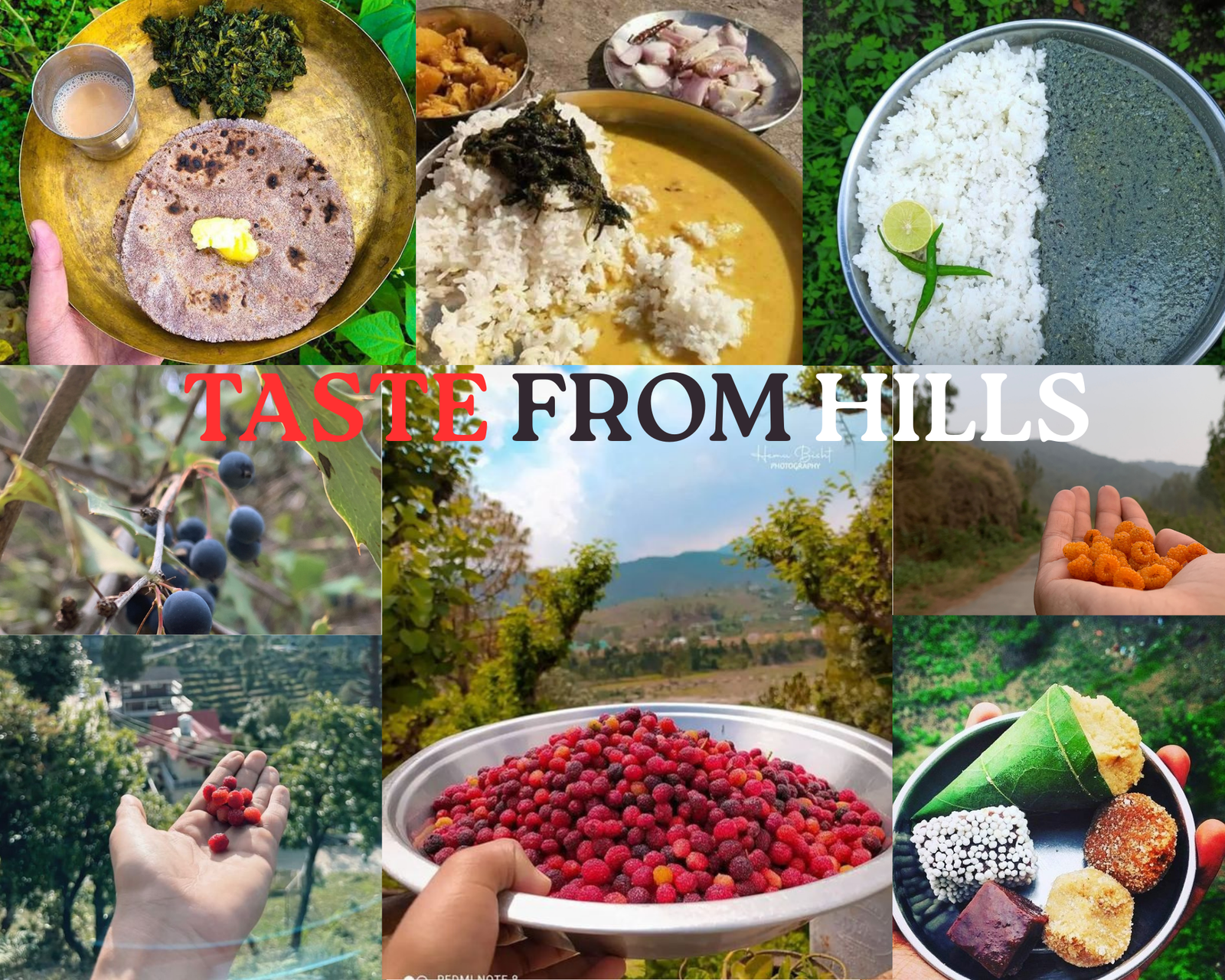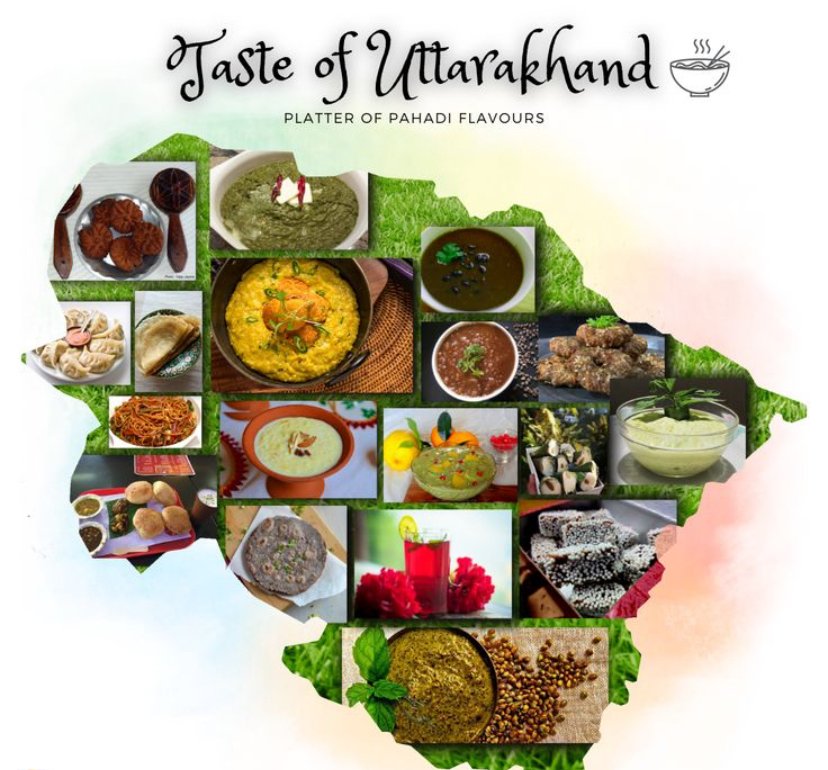
Taste of uttarakhand You know, even now, whenever I think about Uttarakhand, the first thing that hits me isn’t just the snow-capped peaks or the rush of the Ganga during aarti. It’s the food. The smell of ghee warming in a small kitchen, the sound of jakhiya seeds popping in hot oil, the steam rising from a pot of Kafuli—it all hits your senses in a way that feels… magical.
Food here isn’t fancy. It’s not trying to impress anyone. But somehow, it’s so real, so honest, that it stays with you. Every dish carries the mountains in its flavor, and every sweet holds memories of laughter, festivals, and family
LIFE IN THE MOUNTAIN KITCHEN
Life in the hills has never been easy. My grandmother would often tell me stories of how my grandfather would walk miles to fetch vegetables from the fields, and how winters used to freeze even the fires inside the kitchen. It was tough, but it shaped the food culture here—simple, nourishing, and deeply rooted in love.
In the villages, people use mandua (finger millet), jhangora (barnyard millet), and bhatt (black soybean) as staples. The cooking is done with mustard oil, ghee, and local herbs. And then there’s jakhiya seeds—a tiny thing, but when you fry it, the crackling sound fills the kitchen, and for a moment, it feels like magic. I remember running into the kitchen as a kid just to hear that sound.
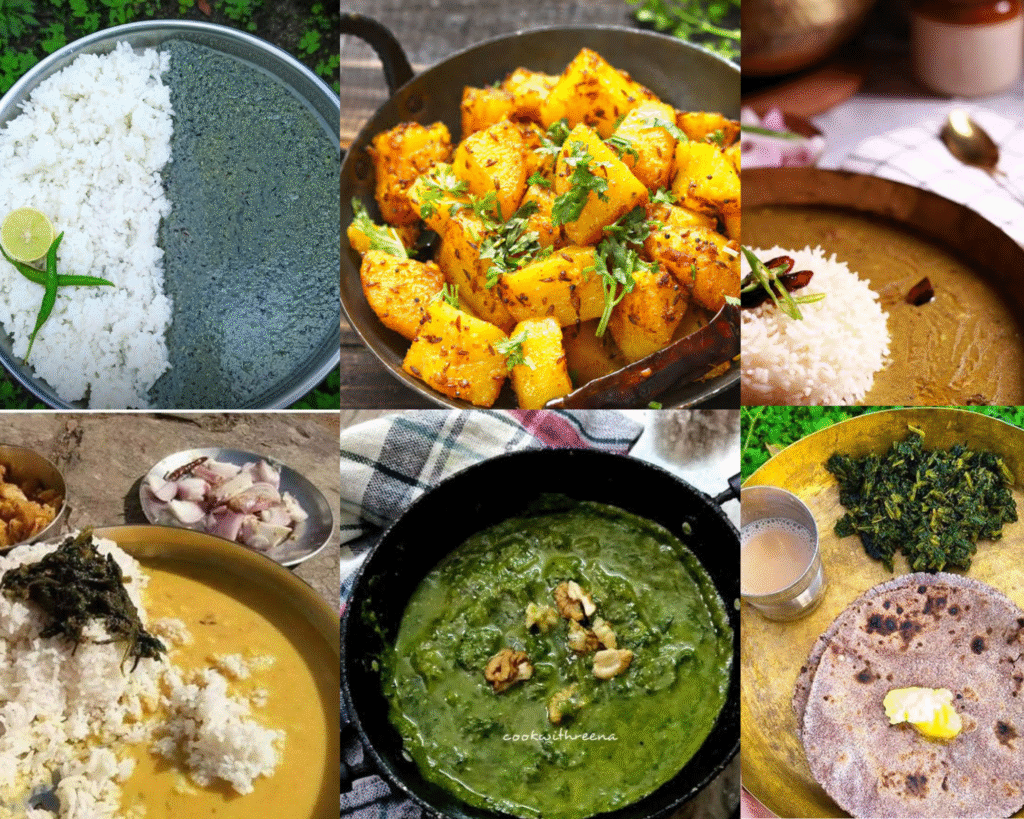
SAVORY DISHES THAT FEEL LIKE HOME
Kafuli – Green Comfort
Ah, Kafuli. Thick, green, made from spinach and fenugreek leaves, slow-cooked and finished with a dollop of ghee. I used to hate green vegetables as a child, but Kafuli changed that. My grandmother would smile as I took my first bite, teasing me, “See? Even the mountains approve!” Eating it with steaming rice during a cold evening feels like a warm hug from the inside out.
Jhoi Bhat – Everyday Magic
If Kafuli is the heartwarming festival dish, Jhoi Bhat is the daily hero. Light, tangy, yogurt-based curry served with rice. After a long day, nothing calms the mind and fills the stomach like Jhoi Bhat. I can still remember sneaking bites while my mother was busy, the tangy flavor making me grin. That’s the magic of everyday food—it’s not glamorous, but it sticks with you.
Chainsoo – Earthy Strength
Chainsoo is made from roasted black gram lentils, coarsely ground and cooked into a thick curry. It smells earthy and tastes even more grounding. My uncle always said, “Chainsoo will make your bones strong, just like the mountains.” Whether or not it did that, it certainly made me feel safe, warm, and fed.
Bhatt ki Churdkani – Hearty and Nutty
Bhatt, black soybeans, slow-cooked until soft and nutty. This dish is protein-packed and deeply comforting. During winter evenings, a bowl of churdkani with rice was all it took to feel strong and content. Even now, the smell of Bhatt ki Churdkani cooking brings back memories of family gatherings in a small village kitchen.
Aloo ke Gutke – Spiced Potato Nostalgia
Potatoes, fried with red chilies and jakhiya seeds, crispy outside, soft inside. Festival mornings meant the whole kitchen filled with the aroma of gutke, puris, and laughter. Cousins would sneak bites while elders weren’t looking. Simple, flavorful, and full of nostalgia.
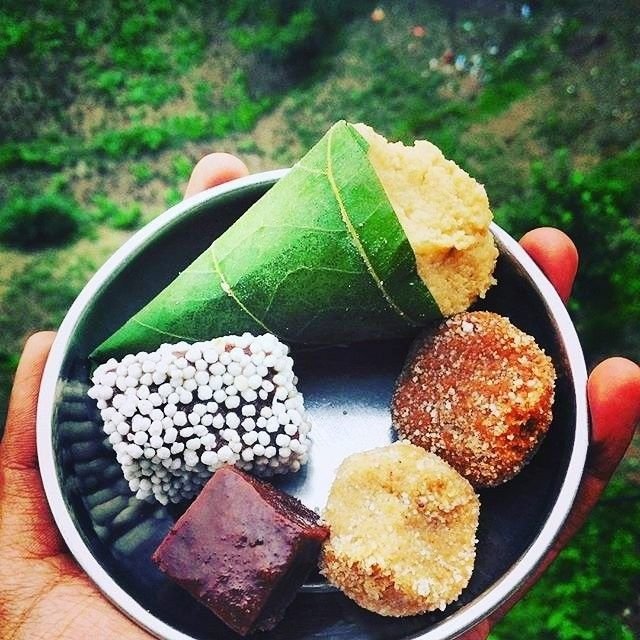
SWEETS MEMORIES FROM THE HILLS
Bal Mithai – Kumaoni Pride
Bal Mithai is khoya fudge coated with tiny sugar balls. Sticky, chewy, slightly nutty. I remember buying it from a tiny shop in Almora as a child with my father. Sugar stuck to my fingers, teeth, and clothes—but I didn’t care. One bite of Bal Mithai, and suddenly, childhood memories flood back.
Singodi – Leaf-Wrapped Surprise
Singodi is khoya and coconut wrapped in maalu leaves. Opening it slowly, inhaling the aroma before taking a bite, feels like unwrapping a small gift from the mountains. Eating Singodi makes you pause and appreciate the little things.
Arsa – Festivals in a Bite
Arsa is rice flour, jaggery, and mustard oil fried to golden perfection. Weddings, Diwali, special occasions—you’ll always find Arsa. I remember my grandmother carefully packing boxes during my cousin’s wedding, and every piece felt like a hug.
Gulgule – Little Jaggery Balls
Tiny fried dumplings made from wheat flour and jaggery. Crispy outside, soft inside. Perfect for a rainy evening, perfect with tea. I used to sit near the stove, watching my grandmother fry them, feeling the warmth and sweetness of both the kitchen and my childhood.
Jhangora ki Kheer – Simple and Pure
Barnyard millet cooked with milk and sugar, creamy, light, gentle. Often made during pujas. The first spoonful takes me back to the smell of incense, the murmur of prayers, and the comforting presence of family.
FOOD AND FESTIVAL INTERTWINED
Food here is never just food. It’s tied to celebrations, prayers, happiness. Makar Sankranti means sesame and jaggery sweets. Harela means green dishes to honor nature. Weddings? Full thali—rice, dal, Kafuli, Jhoi, Gutke, and sweets like Arsa and Gulgule.
And the eating itself is special. People sit cross-legged on pattal, share stories, laugh, and eat together. That’s what makes food in Uttarakhand more than taste—it’s about community, love, and belonging.
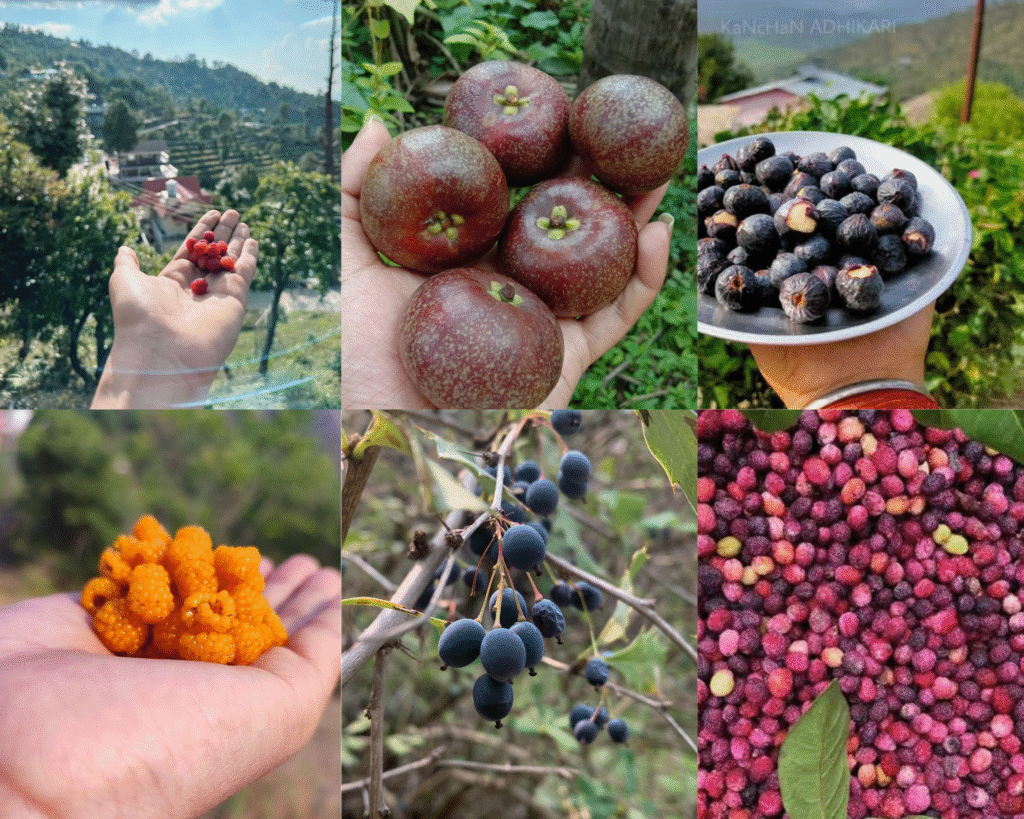
FRUIT FROM HILLS – NATURE’S OWN TREAT
If you’ve grown up in Uttarakhand, you’ll know that fruits here aren’t just something you buy from a market. They’re something you pluck, share, fight over, and sometimes even steal from a neighbor’s orchard (and then run away laughing).
Kafal – The King of Summer Memories
Ask any pahadi about their favorite fruit, and the answer will most likely be kafal. These tiny red berries, tangy and sweet, arrive in early summer. I still remember my cousins and I climbing trees, filling our shirts with kafal, and eating till our tongues turned red. The taste of kafal is more than fruit—it’s childhood bottled into a flavor.
Kilmod – The Wild Tang
Kilmod is a wild, sour berry that you find growing near forests or fields. It’s not the kind of fruit you sit down and eat politely. No—this is the fruit you pop into your mouth while walking, squinting at the sourness, and laughing with friends. Sometimes mothers would make chutney out of it, spicy and tangy, the kind that made you eat twice as much food as usual.
Pulam (Plums) – Juicy Purple Joy
Pulam trees, heavy with purple-red plums in summer, are a sight to remember. The best part? Picking a ripe pulam, wiping it on your sleeve, and biting into it as juice drips down your hands. Sweet, tangy, messy, and perfect. In villages, kids would compete to collect the ripest ones, while the elders sun-dried a batch to use later.
Bedu – The Pahadi Fig
Bedu, the wild fig of the mountains, is another hidden gem. When ripe, it turns sweet and soft, almost like honey inside. I remember village elders plucking bedu during long walks through the forest, offering it to us kids with a smile. “Khajoor se bhi meetha hai yeh,” they’d say. And they were right—one bite, and you understood why pahadis treasure it.
OTHER SESSION DELIGHTS
Of course, the hills also give us Hisalu (tiny golden berries that melt in your mouth), Malta (juicy hill oranges perfect for winters), and apples and peaches from the higher orchards. But somehow, it’s always the wild fruits—kafal, kilmod, bedu—that carry the strongest memories. Maybe because they’re not just fruits, they’re part of growing up in the hills.
WHY UTTRAKHAND FOOD FEELS DIFFRENT
It’s honest. Grounded. Like the mountains themselves. You can eat it in the simplest kitchen and still feel like you’re getting a hug. Even today, in remote villages, grandmothers grind spices by hand, cook on wood fires, and use copper vessels. The food isn’t just nourishment—it’s a connection to generations, to land, to people.
MY PERSONAL MEMORIES
I can close my eyes and remember:
• The first bite of Bal Mithai in Almora, sugar sticking to my lips.
• Kafuli on a freezing winter evening, steam rising from the plate, my grandmother smiling.
• Jhoi Bhat after a long hike, the tangy flavor melting the exhaustion away.
• Gulgule fresh from the pan, my little cousins fighting for the last one.
These dishes aren’t just food—they’re little time machines, carrying me back to laughter, family, and mountains.
FINAL THOUGHT
Uttarakhandi food doesn’t scream. It whispers. Through Kafuli’s warmth, Jhoi’s tang, Gutke’s crunch, and Bal Mithai’s sweetness
If you ever visit the hills, don’t stick to cafes. Go to a home, sit on the floor, taste Kafuli, Jhoi Bhat, Bhatt ki Churdkani, Arsa, and Singodi. You’ll understand—the true beauty of Uttarakhand isn’t just in its peaks or rivers. It’s in kitchens, in stories, in every bite full of love.
Here, food isn’t just eaten. It’s lived.

